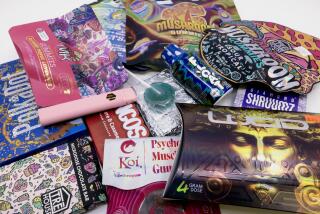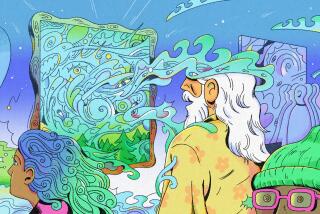Swiss chemist discovered LSD
- Share via
Albert Hofmann, the Swiss chemist who discovered LSD and thereby gave the psychedelic generation the pharmaceutical vehicle to turn on, tune in and drop out, has died. He was 102.
Hofmann died Tuesday morning at his home in Basel, Switzerland, of a heart attack, according to Rick Doblin, the head of MAPS, the Multidisciplinary Assn. for Psychedelic Studies.
Hofmann also identified and synthesized the active ingredients of peyote mushrooms and a Mexican psychoactive plant called ololiuqui and developed at least three related, non-psychoactive compounds that became widely used in medicine.
Those other feats would have been little remembered, however, had he not accidentally gotten a trace amount of an experimental compound called lysergic acid diethylamide on his fingertips and taken the world’s first acid trip.
Hofmann was a talented synthetic chemist working in the Basel research center of Sandoz Laboratories -- now Novartis -- in the 1930s when he began studying the chemistry of ergot, the common name for a fungus that grows on rye, barley and certain other plants. Although ergot is poisonous, midwives had used a crude extract for centuries to induce labor in women.
Twenty years earlier, researchers had isolated ergotamine, the first ergot alkaloid isolated in pure form, and the compound had become widely used for halting bleeding after childbirth and as a treatment for migraine headaches.
In the early 1930s, American researchers had identified the primary active ingredient of ergot, a chemical called lysergic acid. Hofmann devised a technique to make a series of derivatives of lysergic acid called amides and began systematically looking for medically useful compounds.
The 25th compound he synthesized, in 1938, was lysergic acid diethylamide (in German, lyserg-saure-diathylamid), or LSD-25. Because this compound had a chemical structure similar to an existing drug called Coramine, Hofmann had hoped that it would be a stimulant for the respiratory and circulatory systems.
But testing in experimental animals showed no significant activity for the drug -- although the animals were observed to become restless after its administration -- and it was abandoned.
During this period, Hofmann synthesized at least three amides that became drugs: Methergine, used to halt bleeding after birth; Hydergine, which improves circulation in the limbs and cerebral function in the elderly; and Dihydergot, used to stabilize circulation and blood pressure.
Prompted by what Hofmann later described as a “peculiar presentiment” that LSD-25 might have properties other than those established in the first investigations, he decided to look at it again.
On Friday afternoon, April 16, 1943, Hofmann had just completed synthesizing a new batch when, he subsequently wrote to his supervisor, “I was forced to interrupt my work in the laboratory in the middle of the afternoon and proceed home, being affected by a remarkable restlessness, combined with slight dizziness.
“At home, I lay down and sank into a not-unpleasant intoxicated-like condition, characterized by an extremely stimulated imagination. In a dreamlike state I perceived an uninterrupted stream of fantastic pictures, extraordinary shapes with intense, kaleidoscopic play of colors. After some two hours, this condition faded away.”
Hofmann suspected that the state had been caused by something in the lab. In an interview on his 100th birthday, he said, “I didn’t know what caused it, but I knew that it was important.”
After breathing the solvents he had used produced no effect, Hofmann suspected that the synthetic drug was the source. “LSD spoke to me,” he said. “He came to me and said, ‘You must find me.’ He told me, ‘Don’t give me to the pharmacologist, he won’t find anything.’ ”
The next Monday, he took what he considered to be an extremely small dose of LSD, so small that a similar dose of even the most powerful toxin known at the time would have had little or no effect. He had planned to gradually increase the dosage but instead was surprised to encounter the first bad acid trip.
Feeling bad, he asked his laboratory assistant to accompany him home on his bicycle, no cars being available because of World War II restrictions. During the trip, “I had the feeling that I could not move from the spot. I was cycling, cycling, but the time seemed to stand still.”
By the time they reached his home, its furnishings had transformed themselves into terrifying objects.
“Everything in the room spun around, and the familiar objects and pieces of furniture assumed grotesque, threatening forms,” he wrote in his autobiography, “LSD: My Problem Child.” “They were in constant motion, animated, as if driven by an inner restlessness. The lady next door [became] a malevolent, insidious witch with a colored mask.”
Hofmann thought he was dying and sent for a doctor, but the physician could find nothing wrong.
After about six hours, the experience began to change into a pleasant one.
“After some time, with my eyes closed, I began to enjoy this wonderful play of colors and forms, which it really was a pleasure to observe. Then I went to sleep and the next day I was fine. I felt quite fresh, like a newborn.”
That day, April 19, has subsequently been celebrated by LSD proponents as “Bicycle Day.”
Hofmann’s bosses did not believe the drug could be so powerful, concluding that he had measured the dosage incorrectly. Two laboratory assistants subsequently took doses only a fifth of what Hofmann had consumed, and they too had powerful experiences.
LSD was initially hailed as a wonder drug for use in psychoanalysis, particularly for gaining insights into schizophrenia; more than 2,000 research papers appeared over the succeeding decade.
The Central Intelligence Agency investigated LSD as a potential agent for mind control, and the British government studied it as a truth drug. In both cases, the drug was administered to subjects who were not informed of its nature, leading to scandals and changes in regulations about informed consent.
But in the 1960s, largely at the instigation of Harvard University psychologists Timothy Leary and Richard Alpert, LSD began to be seen first as a pathway to spiritual enlightenment, then as a major recreational drug.
“Instead of a ‘wonder child,’ LSD suddenly became my ‘problem child,’ ” Hofmann said.
In 1966, the United States banned its use, followed by most other countries. Nonetheless, some still consider it a promising drug, and research continues on its medical potential.
Meanwhile, Hofmann read that American ethnologist Gordon Wasson had discovered mushrooms that were used for ritual purposes by Indians and that produced an LSD-like effect. Other researchers had little success extracting the active ingredient, and a sample was sent to Basel.
Hofmann’s initial tests in animals appeared to show no effect from the mushrooms. Before discarding them, however, Hofmann decided to sample them and had what he called “a full-blown LSD experience.”
He and his assistants then isolated the active ingredients, using themselves as guinea pigs. At every purification step, they would consume the product to make sure it still contained the active agent.
Ultimately, they isolated two active ingredients, which Hofmann named psilocybin and psilocin because they had been isolated from Psilocybe mexicana. They turned out to be about 1% as active as LSD.
On a later visit to Mexico, Hofmann gave a bottle of psilocybin tablets to Maria Sabina, the shaman who had originally given the mushrooms to Wasson. “When we left, Maria Sabina told us that the tablets really contained the spirit of the mushrooms,” Hofmann said.
On that visit, Hofmann collected a batch of morning glory seeds that the natives called ololiuqui. Using the same approach as with the mushrooms, he isolated the active ingredients and found them to be lysergic acid monoamide and lysergic acid hydroxyethylamide. “They were derivatives of lysergic acid that I had on my shelf through my studies with LSD,” he said.
Once again, his colleagues didn’t believe him because the lysergic acid derivatives came from a species completely different from ergot. They assumed that his final products were contaminants introduced in the laboratory. And once again he was shown to be correct.
By this time, LSD had developed its negative reputation, and Sandoz decided it no longer wanted anything to do with ergot derivatives.
But Hofmann’s life had already been altered. LSD and the other psychoactive drugs “changed my life, insofar as they provided me with a new concept about what reality is,” he said. “Before, I had believed there was only one reality: the reality of everyday life.
“Under LSD, however, I entered into realities which were as real and even more real than the one of everyday.” He also “became aware of the wonder of creation, the magnificence of nature and of the plant and animal kingdom. I became very sensitive to what will happen to all this and all of us.”
After dozens of acid trips, Hofmann finally gave up psychedelics. “I know LSD; I don’t need to take it anymore,” he said.
Hofmann is survived by his wife, Anita; two daughters; a son; eight grandchildren; and six great-grandchildren.
--






